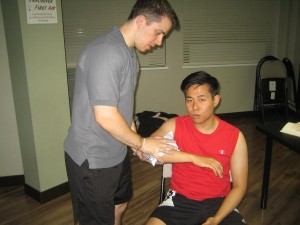If an individual has an overworked elbow or commonly called as tennis elbow, it is basically a condition that results to pain on the exterior part of the elbow while at the same time weakening the grip strength of the individual. Take note that this condition can also affect individuals who do not engage in sports. Any repetitive motion of the elbow over an extended period of time can lead to the development of microscopic tears in the tendons of the elbow, resulting to pain. If an individual experiences pain in the elbow, it can indicate an overworked elbow that requires proper assessment by a doctor so that the appropriate treatment plan can be started.
Rest and application of ice for an overworked elbow
The initial first aid measures when managing an overworked elbow is to encourage the individual to rest and apply ice on the affected area. While the individual is resting, you have to elevate the elbow higher than the level of the heart to minimize any swelling in the affected area while at the same time provide pain relief.

When applying an ice pack, it must be done six times in a day for 15 minutes at a time to minimize the inflammation and pain. A sling can be applied in order to prevent using the already overworked elbow. The doctor can help determine the length of time required to rest the elbow but it often takes several weeks before the individual can engage in sports or strenuous physical activities.
Pain medications
It is important to note that both oral and topical non-steroidal anti-inflammatory medications can help minimize the pain for up to four weeks. Take note that these medications are highly effective in diminishing the pain and swelling. Nevertheless, if the pain is chronic or severe, corticosteroid injections are highly effective. Even if this mode of treatment is effective, the pain will usually return after six weeks. The administration of repeated injections can increase the recurrence of the symptoms while at the same time reduce the chances of improvement.
Pain therapies
Ultrasound, extracorporeal shock wave therapy and massage are good alternatives when rest, application of ice and pain medications does not work. On the other hand, it is important to note that there is inadequate evidence to support the effectiveness of these therapies and if relief is achieved, the results tend to be short-lived.
Surgical intervention
Surgery might be required if the symptoms persist for six to twelve months. The surgery typically involves the removal of the affected muscle and reattaching a healthy muscle back to the bone. The elbow is immobilized using a splint and the sutures are removed after a week. Physical therapy exercises must be started to strengthen and improve the flexibility of the forearm. The risks involved if surgery is performed include infection, weakness, nerve damage, and loss of flexibility and the possibility of undergoing another surgery in the future.
